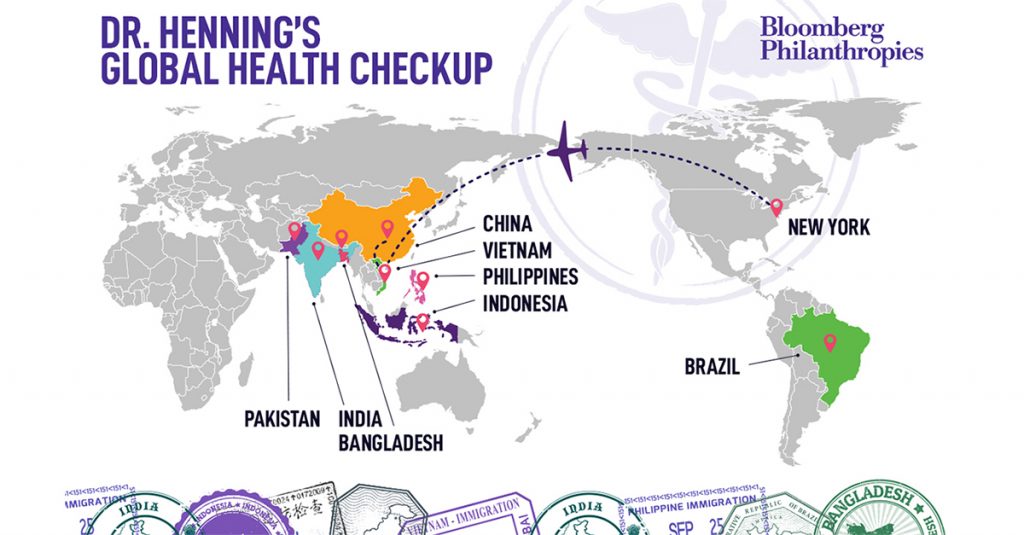Global Health Checkup: Celebrating Progress in Vietnam to Reduce Tobacco Use, Seeking Opportunities to Go Further

By Dr. Kelly Henning, Public Health program lead at Bloomberg Philanthropies
This is the second post in a series by Dr. Henning reflecting on her visits throughout the year ahead to Brazil, Vietnam, China, Indonesia, Philippines, Bangladesh and India to see firsthand the successes and challenges our partners face in tackling noncommunicable diseases (NCDs) in their communities. Click here to read part one: Brazil.
Vietnam is a country of varied pleasures: pristine beaches, rolling hills and mountainous terrain, bustling cities and peaceful Buddhist temples, to say nothing of the delicious food. My recent visit left me inspired and excited about the potential opportunities to continue to improve the health of the Vietnamese people in collaboration with many of our partners.
An astounding 45 percent of adult males in Vietnam use tobacco, compared to only 1 percent of women. These high smoking rates among men in Vietnam are at the core of the country’s health problems with more than 40,000 tobacco-related deaths each year.
The challenges in Vietnam are difficult, but surmountable. Bloomberg Philanthropies’ deep collaboration with the government and local organizations demonstrates that together we can make real strides toward reducing tobacco use in this country of nearly 100 million people.
During my three days in the capital Hanoi, I enjoyed the sights, sounds, and smells of the bustling city. I wasn’t alone, though. Whether at the hotel, a National Assembly office, or over a delicious lunch (I recommend the mien tron), I listened to our local partners share recent successes and challenges in lowering tobacco use in the country.
Through these spirited conversations it became clear to me that there are two promising opportunities to mitigate tobacco use in Vietnam: strengthening the Comprehensive Tobacco Control Law and increasing taxes on tobacco products.
Strengthening the Comprehensive Tobacco Control Law
The Ministry of Health has made significant strides in monitoring tobacco use in the country. We are building on that success by collaborating with the health ministry and with key committees of the National Assembly to strengthen regulation and enforcement of the Tobacco Control Law of 2012.
The Tobacco Control Law established the Vietnam Tobacco Control Fund, which supports tobacco control activities that are funded by required contributions from the tobacco industry. Ironically, the government – by owning Vinataba, the Vietnam National Tobacco Corporation – controls over 50 percent of market share, thereby having an outsized influence on setting the very low prices for tobacco.
Enforcing the Tobacco Control Law is a real challenge. For example, the law states that you can’t advertise cigarettes at the point of sale, but enforcement is weak and advertising at check-out is broadly evident. I saw this firsthand walking through the crowded streets – the tobacco signs in the stalls were visible to everyone within sight – including, of course, impressionable children.
Another area of concern is enforcement of smoke free public places; strengthening the law to include 100 percent smoke free coverage of all indoor public places – without exception – would greatly improve enforcement and compliance. We look forward to supporting the Ministry of Health in this area.
Increasing Taxes on Tobacco Products
Because of low tobacco prices, smoking prevalence among men has not dropped significantly since the passage of the comprehensive law in 2012. With such low prices, there’s little incentive for users to quit. I could hardly walk down the block or through a narrow street without encountering second-hand smoke. It’s very noticeable.
Research shows that simply increasing taxes on tobacco products results in decreased usage. One proposal being discussed in the National Assembly increases taxes on tobacco products by at least 1,000 dong (approximately 4 cents in USD). A tax of 1,000 dong is a start, but it’s not nearly enough. Research shows that for Vietnam to achieve its goal of reducing tobacco use by 8 percent by 2020, the real price hike should be at least 5,000 dong (approximately 22 cents in USD).
On this front, Vietnam’s Women’s Union has been a fantastic partner. This dynamic group – which boasts a membership of 13 million – is a strong advocate for increasing taxes on tobacco products. And they’re instrumental in spreading knowledge about the dangers of smoking through mass media campaigns. My colleagues and I had the privilege of attending a workshop on this topic with the Women’s Union. Their enthusiasm to fight for a 5,000 dong tax increase was infectious.
The efforts to strengthen the Tobacco Control Law and to increase taxes aren’t the only tools that should be used to reduce tobacco use in Vietnam. Partners can continue educating the public on the dangers of tobacco for smokers and non-smokers alike, and encourage more resources for enforcing already strong laws.
My trip to Vietnam was short – too short – but the proposals our local partners are pushing to create a healthier Vietnam will have lasting effects.
I look forward to my return trip where we will toast their successes – over a glass of freshly squeezed lychee juice!